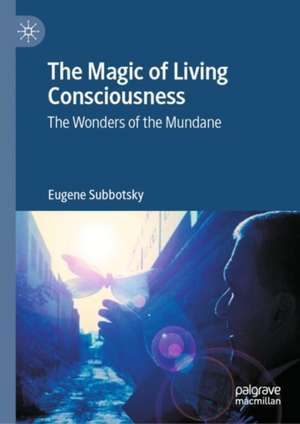The Magic of Living Consciousness: The Wonders of the Mundane
Autor Eugene Subbotskyen Limba Engleză Hardback – 4 iun 2024
The magnificent success of science in the modern world has plunged many scientists into the illusion that magical events are ancient history and exist today only in art and night dreams. The illusion reached its pinnacle in the middle of the 20th century, when nuclear power stations, flights to the Moon, early computers, genetic engineering and other wonders of science made some scientists believe that there is nothing in the world that cannot be explained by science. But there was a price to pay for this scientific optimism – the scientists became blind to their living consciousness. They began looking at the world as if nature and objectified consciousness were the only things that mattered, with living consciousness being viewed as a mundane thing that accompanies brain processes but has no causal powers.
This book examines how our living consciousness works, and how our understanding of this work helps in solving key problems of modern life, such as facilitating creativity, protecting from magical manipulation with minds, fighting certain kinds of crime, managing fake reality, preventing misuses in psychotherapy and other psychological practices, comprehending controversial issues in science, and tracing origins of totalitarian media narratives that trigger hatred and wars.
Preț: 778.44 lei
Preț vechi: 819.41 lei
-5% Nou
Puncte Express: 1168
Preț estimativ în valută:
148.95€ • 155.53$ • 123.00£
148.95€ • 155.53$ • 123.00£
Carte tipărită la comandă
Livrare economică 15-29 aprilie
Preluare comenzi: 021 569.72.76
Specificații
ISBN-13: 9783031547072
ISBN-10: 3031547071
Ilustrații: XIII, 198 p. 10 illus., 9 illus. in color.
Dimensiuni: 148 x 210 mm
Greutate: 0.41 kg
Ediția:2024
Editura: Springer Nature Switzerland
Colecția Palgrave Macmillan
Locul publicării:Cham, Switzerland
ISBN-10: 3031547071
Ilustrații: XIII, 198 p. 10 illus., 9 illus. in color.
Dimensiuni: 148 x 210 mm
Greutate: 0.41 kg
Ediția:2024
Editura: Springer Nature Switzerland
Colecția Palgrave Macmillan
Locul publicării:Cham, Switzerland
Cuprins
Part I: Living Consciousness in Communication and Education.-Chapter 1. Living Consciousness: Introduction.- Chapter 2. Living Consciousness and the Cultural-historical Method: Limits of Applicability.- Chapter 3. Magical Thinking and Experience as Dimensions of Living Consciousness.- Part II: Living Consciousness and the Universe.-Chapter 4. Man in the Mirror of Nature: Science and Living Consciousness.- Chapter 5. Is Living Consciousness a Simulation? Children’s and Adults’ Reactions to the ‘Person is a simulation’ Hypothesis.- Chapter 6. Living Consciousness in Historical Context.- Part III: Living Consciousness in Modern Life and Society.-Chapter 7. Reason in the Cobweb: Magical Manipulation of Living Consciousness.- Chapter 8. Fake-reality: Cheating on Living Consciousness on a Mass Scale.- Chapter 9. Totalitarian Media Narratives: Living Consciousness in Captivity.- Chapter 10. Golem: Living Consciousness without the Brain.-The Mysteries of the Mundane: Epilogue and summary.
Notă biografică
Eugene Subbotsky is a Reader Emeritus in Developmental Psychology at the University of Lancaster, UK. He is known internationally for research on children’s moral development, the development of children’s metaphysical reasoning, and the development of consciousness and magical thinking over life span.
Textul de pe ultima copertă
This book demystifies the notion of living consciousness and aims to show that, far from being a mere accompaniment to brain functions, living consciousness defines the features of both physical objects and human artifacts. The distinction is between living consciousness, which includes subjective experiences ‘here and now’ (e.g., perceptions, feelings, imagination, and creative thinking) and conforms to the laws of magic, versus objectified consciousness that comprises physical (e.g., computers) and symbolic (e.g., languages and concepts) human artifacts and conforms to the laws of nature and formal logic.
The magnificent success of science in the modern world has plunged many scientists into the illusion that magical events are ancient history and exist today only in art and night dreams. The illusion reached its pinnacle in the middle of the 20th century, when nuclear power stations, flights to the Moon, early computers, genetic engineering and other wonders of science made some scientists believe that there is nothing in the world that cannot be explained by science. But there was a price to pay for this scientific optimism – the scientists became blind to their living consciousness. They began looking at the world as if nature and objectified consciousness were the only things that mattered, with living consciousness being viewed as a mundane thing that accompanies brain processes but has no causal powers.
This book examines how our living consciousness works, and how our understanding of this work helps in solving key problems of modern life, such as facilitating creativity, protecting from magical manipulation with minds, fighting certain kinds of crime, managing fake reality, preventing misuses in psychotherapy and other psychological practices, comprehending controversial issues in science, and tracing origins of totalitarian media narratives that trigger hatred and wars.
Eugene Subbotsky is a Reader Emeritus in Developmental Psychology at the University of Lancaster, UK. He is known internationally for research on children’s moral development, the development of children’s metaphysical reasoning, and the development of consciousness and magical thinking over life span.
This book examines how our living consciousness works, and how our understanding of this work helps in solving key problems of modern life, such as facilitating creativity, protecting from magical manipulation with minds, fighting certain kinds of crime, managing fake reality, preventing misuses in psychotherapy and other psychological practices, comprehending controversial issues in science, and tracing origins of totalitarian media narratives that trigger hatred and wars.
Eugene Subbotsky is a Reader Emeritus in Developmental Psychology at the University of Lancaster, UK. He is known internationally for research on children’s moral development, the development of children’s metaphysical reasoning, and the development of consciousness and magical thinking over life span.
Caracteristici
Examines the distinction between living consciousness and objective consciousness Details the promotion of living consciousness to enhance creativity and improve memory Tracks changes in our understanding of living consciousness from the Renaissance period
